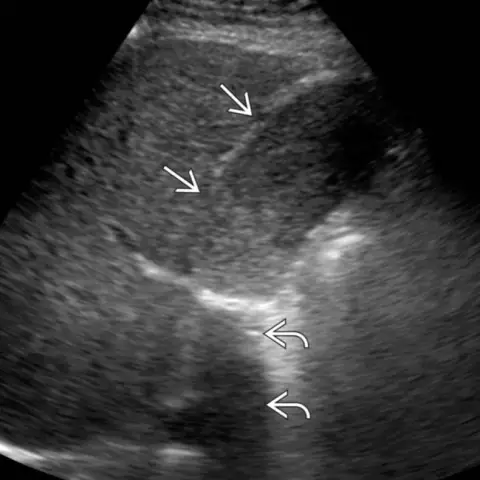- Author Rachel Wainwright [email protected].
- Public 2023-12-15 07:39.
- Last modified 2025-11-02 20:14.
Stagnation of bile
The content of the article:
- Forms
- Causes of bile stasis and risk factors
- Signs of bile stagnation
- Features of stagnation of bile in pregnant women
- Features of stagnation of bile in a child
- Diagnostics
- Treatment of bile stasis
- Possible complications and consequences
- Forecast
- Prevention
Stagnation of bile (cholestasis) is a symptom caused by a violation of the synthesis, secretion and outflow of bile or its individual components into the duodenum.
When the synthesis of bile is disturbed, its properties and component composition change. In this case, the elements of bile (hydrophobic bile acids, bilirubin, cholesterol) begin to have a toxic effect on liver cells and intrahepatic bile ducts, reducing the permeability of their membranes and reducing the activity of carrier proteins. If there are structural changes in the walls of the bile ducts, overlap of the lumen from the inside or compression of the bile ducts from the outside, then the outflow of bile through the extrahepatic ducts becomes difficult.
Forms
Depending on the causes of cholestasis, there are two main forms: extrahepatic and intrahepatic.

Source: umedp.ru
Extrahepatic stagnation of bile is characterized by disturbances in the structure and functions of the biliary system due to mechanical factors and obstruction of the extrahepatic biliary tract, obstacles to the outflow of bile are in the area of the extrahepatic bile ducts.
Intrahepatic stasis of bile is associated with a violation of the synthesis of bile components and its entry into the bile capillaries. Depending on the level of damage, intrahepatic cholestasis is of the following types:
- intracellular, proceeding with damage to hepatocytes;
- intratubular, in which damage to the transport systems of membranes occurs;
- ductular, characterized by a violation of the structure of the duct epithelium;
- mixed.
By the features of occurrence:
- partial cholestasis - characterized by a decrease in the volume of secreted bile;
- dissociated cholestasis - characterized by a delay in the individual components of bile;
- total cholestasis - proceeds with a complete violation of the flow of bile into the duodenum.
By the nature of the course, bile stagnation is divided into acute and chronic, it can proceed in an icteric or anicteric form.
Causes of bile stasis and risk factors
Possible causes of bile stagnation:
- alcoholic liver damage;
- autoimmune liver disease (autoimmune hepatitis);
- endocrine system pathology (hypopituitarism, hypothyroidism);
- metabolic disorders (cystic fibrosis, galactosemia, tyrosinemia);
- hormonal changes during pregnancy (cholestasis of pregnancy);
- infectious lesions (hepatitis, Epstein-Barr virus);
- chromosomal abnormalities;
- toxic liver damage (poisoning with some poisons, in particular, heavy metal salts);
- medicated liver damage (side effects of steroid hormones, non-steroidal anti-inflammatory drugs);
- hereditary diseases (Alagille's syndrome, Beler's disease);
- cholelithiasis;
- stricture (narrowing) of the bile duct;
- chronic diseases of the digestive tract (pancreatitis, ulcers, gastritis, inflammation in the small intestine);
- spasm of the sphincter of Oddi;
- primary biliary cirrhosis;
- diseases of the duodenum;
- malignant tumor of the pancreas;
- Caroli's disease;
- lymphogranulomatosis.
In addition, the reasons for stagnation of bile can be a lack of diet, overeating, smoking, drinking alcohol, and a sedentary lifestyle.

Source: umedp.ru
Signs of bile stagnation
The formation of symptoms of stagnation of bile is influenced by the excessive flow of its elements into the tissues and blood, the effect of bile and its metabolites on hepatocytes and liver tubules, a decrease in the amount or complete absence of bile in the intestine.
For any form of bile stagnation, a number of common symptoms are characteristic:
- soreness, a feeling of heaviness in the area of the right hypochondrium;
- darkening of urine;
- bad breath;
- violations of the processes of digestion and absorption;
- flatulence;
- alternation of constipation and diarrhea;
- heartburn, bouts of nausea, belching;
- discoloration of feces (acholic feces);
- an increase in the size of the liver;
- jaundice;
- itchy skin.
Symptoms of bile stagnation are also skin pigmentation and cholesterol deposits in the form of xanthomas and xanthelasmas on the skin of the neck, back, chest, palms, near the eyes.

Source: gidmed.com
Features of stagnation of bile in pregnant women
Cholestasis in pregnant women develops closer to the third trimester. Its appearance is often due to a hereditary factor. The main symptom is itchy skin and xanthomas in the upper body. Due to the lack of vitamin K, there is a risk of uterine bleeding. If bile acid or its components penetrate the placenta, the risk of premature birth at a short time increases, as well as heart rhythm disturbances in the child.
Clinical manifestations disappear after childbirth, however, it has been established that women who have had cholestasis during pregnancy further increase the risk of developing gallstone disease, hepatitis C, non-alcoholic cirrhosis and pancreatitis.
Features of stagnation of bile in a child
In a child, cholestasis rarely manifests itself with severe symptoms, which is why it is often detected late. If time is missed, children may develop cholangitis and liver cirrhosis.
One of the obvious manifestations of cholestasis in childhood is skin itching. If the itching is severe, children scratch the skin hard, leaving abrasions. The skin thickens and becomes dry. Children under 5 months of age do not have this symptom.
Early symptoms of bile stagnation in a child are also a pale gray skin tone, cracks in the corners of the mouth, plaque on the tongue, and discoloration of the stool.
With an increase in the level of bilirubin in the blood, yellowness appears in the mucous membrane of the eyes, the skin becomes yellowish. Jaundice-induced bile stasis is common in newborns and children under six months of age.
Diagnostics
Bile stagnation is determined based on the history of the disease, complaints and the presence of characteristic symptoms. When examining the patient, the gastroenterologist identifies the severity of the symptoms and the duration of their occurrence, assesses the condition of the skin, determines the size of the liver using palpation and percussion, prescribes laboratory and instrumental examination.
General and biochemical blood tests, analysis for the presence of parasitic infections, and urinalysis are prescribed. The results of a general blood test will help determine the presence of anemia, neutrophilic leukocytosis. A biochemical blood test reveals hyperbilirubinemia (an increase in the bile pigment of bilirubin in the blood), hyperlipidemia (an increase in lipids), an increase in the level of enzyme activity (alkaline phosphatase, leucine aminopeptidase, 5-nucleotidase, glutamyl transpeptidase). Urinalysis reveals the presence of bile pigments, urobilin. They also diagnose autoimmune liver diseases using enzyme immunoassay.
Instrumental research methods:
- Ultrasound of the abdominal organs - is performed to detect an increase in the size of the liver, expansion of the bile ducts, changes in the gallbladder, the presence of stones in it;
- cholangiography - prescribed when supra-stenotic expansion of the ducts is detected;
- endoscopic retrograde cholangiopancreatography (ERCH) - based on a study with a contrast agent, is effective for detecting stones, primary sclerosing cholangitis;
- percutaneous transhepatic cholangiography (PCCG) - used when it is impossible to conduct a contrast study;
- liver biopsy - performed only with intrahepatic bile stasis;
- cholescintigraphy - allows you to identify the localization of the lesion (inside or extrahepatic), is carried out with the use of iminodiacetic acid labeled with technetium;
- magnetic resonance cholangiography is a non-invasive replacement for ERCH.
Differential diagnosis of extra- and intrahepatic cholestasis:
| Criteria | Extrahepatic cholestasis | Intrahepatic cholestasis |
| Anamnesis data | Abdominal pain, fever, middle age or old age, biliary tract surgery | Anorexia, malaise, contact with blood, blood transfusion, drug injections, drug addiction |
| Objective examination | Fever, tight abdomen, palpable gallbladder | Ascites, signs of chronic liver disease, enteropathy |
| Laboratory data | Parallel increase in bilirubin and alkaline phosphatase levels | High levels of alkaline phosphatase without increased bilirubin. Simultaneous increase in serum transaminases |
Treatment of bile stasis
The main goal of the treatment of bile stagnation is to influence the causative factor, that is, the therapy of the disease that caused it, the restoration of the disturbed mechanisms of bile transport and the relief of symptoms. For this, drug therapy or surgery can be used.
Depending on the severity of the disease and the severity of the symptoms, pathogenetic therapy is performed. The most effective drugs that affect pathogenetic links are hepatoprotectors (Heptral, Karsil), which have anticholestatic and immunomodulatory activity, and ursodeoxycholic acid preparations (Ursosan, Ursofalk), which help to reduce the level of toxic hydrophobic bile acids and excrete choleretic …
For the treatment of itching that occurs, inducers of enzymes of microsomal oxidation in hepatocytes (Phenobarbital), opiate antagonists (Naloxon, Nalmefen), blockers of serotonin receptors (Ondansetron), blockers of H1-histamine receptors (Tavegil, Pipolphene) are used, and a course of plasma ultraviolet radiation is prescribed.
To replenish the lack of trace elements, it is advisable to take multivitamin complexes with an increased content of fat-soluble vitamins A and E, with symptoms of osteoporosis - vitamin D3 with calcium preparations, with bleeding and hemorrhagic manifestations - vitamin K, with pain in the bones - calcium gluconate. Additionally, enzyme preparations (Pancitrate, Creon), antioxidants, antihistamines are used.
An important element of therapy is diet for bile stasis. It is impossible to cure cholestasis without the patient's diet. Animal fats, fatty, spicy, fried, smoked, canned foods, spices, pastries, chocolate, mushrooms, legumes, radishes, and alcohol are excluded from the diet. The diet is based on fresh vegetables and fruits, fermented milk products, vegetable fats (sunflower, olive, corn oil), includes the use of medicinal mineral waters. Avoid eating cold foods and drinks. It is recommended to cook dishes using dietary methods: steamed, in the oven or in a slow cooker. Meals should be fractional, that is, at least six meals a day in small portions, it is necessary to monitor the amount of food in order to prevent overeating.
Surgical methods of treating cholestasis include interventions that restore bile secretion (cholecystectomy, opening the gallbladder), drainage of the biliary tract, endoscopic and percutaneous transhepatic stenting.

Source: umedp.ru
Possible complications and consequences
In chronic bile stasis due to impaired absorption of fat-soluble vitamins, hepatic osteodystrophy, deterioration of twilight vision ("night blindness"), increased bleeding, dehydration, chronic diarrhea with impaired fat absorption, impaired copper metabolism, changes in the cardiovascular system can develop.
With a long and uncompensated course of cholestasis, complications are possible:
- the formation of stones in the gallbladder and bile ducts;
- cirrhosis of the liver;
- liver failure;
- hepatic encephalopathy;
- sepsis.
Forecast
The prognosis with proper treatment and adherence to preventive measures is favorable.
Prevention
Prevention of bile stagnation is to prevent the occurrence of diseases of the biliary tract and liver that contribute to the development of cholestasis, it also involves adherence to the correct diet, refusal to overeat and drink alcohol.
YouTube video related to the article:

Anna Aksenova Medical journalist About the author
Education: 2004-2007 "First Kiev Medical College" specialty "Laboratory Diagnostics".
The information is generalized and provided for informational purposes only. At the first sign of illness, see your doctor. Self-medication is hazardous to health!






